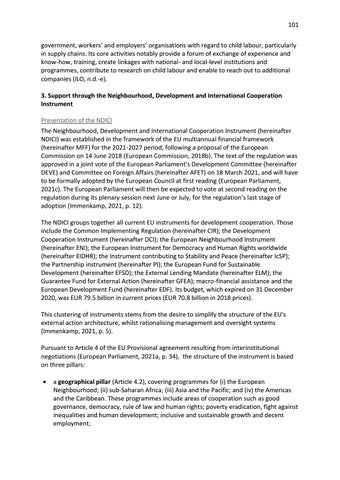101 government, workers’ and employers’ organisations with regard to child labour, particularly in supply chains. Its core activities notably provide a forum of exchange of experience and know-how, training, create linkages with national- and local-level institutions and programmes, contribute to research on child labour and enable to reach out to additional companies (ILO, n.d.-e). 3. Support through the Neighbourhood, Development and International Cooperation Instrument Presentation of the NDICI The Neighbourhood, Development and International Cooperation Instrument (hereinafter NDICI) was established in the framework of the EU multiannual financial framework (hereinafter MFF) for the 2021-2027 period, following a proposal of the European Commission on 14 June 2018 (European Commission, 2018b). The text of the regulation was approved in a joint vote of the European Parliament’s Development Committee (hereinafter DEVE) and Committee on Foreign Affairs (hereinafter AFET) on 18 March 2021, and will have to be formally adopted by the European Council at first reading (European Parliament, 2021c). The European Parliament will then be expected to vote at second reading on the regulation during its plenary session next June or July, for the regulation’s last stage of adoption (Immenkamp, 2021, p. 12). The NDICI groups together all current EU instruments for development cooperation. Those include the Common Implementing Regulation (hereinafter CIR); the Development Cooperation Instrument (hereinafter DCI); the European Neighbourhood Instrument (hereinafter ENI); the European Instrument for Democracy and Human Rights worldwide (hereinafter EIDHR); the Instrument contributing to Stability and Peace (hereinafter IcSP); the Partnership instrument (hereinafter PI); the European Fund for Sustainable Development (hereinafter EFSD); the External Lending Mandate (hereinafter ELM); the Guarantee Fund for External Action (hereinafter GFEA); macro-financial assistance and the European Development Fund (hereinafter EDF). Its budget, which expired on 31 December 2020, was EUR 79.5 billion in current prices (EUR 70.8 billion in 2018 prices). This clustering of instruments stems from the desire to simplify the structure of the EU's external action architecture, whilst rationalising management and oversight systems (Immenkamp, 2021, p. 5). Pursuant to Article 4 of the EU Provisional agreement resulting from interinstitutional negotiations (European Parliament, 2021a, p. 34), the structure of the instrument is based on three pillars: •
a geographical pillar (Article 4.2), covering programmes for (i) the European Neighbourhood; (ii) sub-Saharan Africa; (iii) Asia and the Pacific; and (iv) the Americas and the Caribbean. These programmes include areas of cooperation such as good governance, democracy, rule of law and human rights; poverty eradication, fight against inequalities and human development; inclusive and sustainable growth and decent employment;













